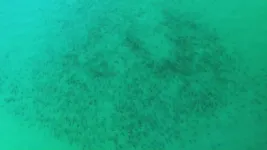(Press-News.org) For every kilogram of matter that we can see — from the computer on your desk to distant stars and galaxies — there are 5 kilograms of invisible matter that suffuse our surroundings. This “dark matter” is a mysterious entity that evades all forms of direct observation yet makes its presence felt through its invisible pull on visible objects.
Fifty years ago, physicist Stephen Hawking offered one idea for what dark matter might be: a population of black holes, which might have formed very soon after the Big Bang. Such “primordial” black holes would not have been the goliaths that we detect today, but rather microscopic regions of ultradense matter that would have formed in the first quintillionth of a second following the Big Bang and then collapsed and scattered across the cosmos, tugging on surrounding space-time in ways that could explain the dark matter that we know today.
Now, MIT physicists have found that this primordial process also would have produced some unexpected companions: even smaller black holes with unprecedented amounts of a nuclear-physics property known as “color charge.”
These smallest, “super-charged” black holes would have been an entirely new state of matter, which likely evaporated a fraction of a second after they spawned. Yet they could still have influenced a key cosmological transition: the time when the first atomic nuclei were forged. The physicists postulate that the color-charged black holes could have affected the balance of fusing nuclei, in a way that astronomers might someday detect with future measurements. Such an observation would point convincingly to primordial black holes as the root of all dark matter today.
“Even though these short-lived, exotic creatures are not around today, they could have affected cosmic history in ways that could show up in subtle signals today,” says David Kaiser, the Germeshausen Professor of the History of Science and professor of physics at MIT. “Within the idea that all dark matter could be accounted for by black holes, this gives us new things to look for.”
Kaiser and his co-author, MIT graduate student Elba Alonso-Monsalve, have published their study today in the journal Physical Review Letters.
A time before stars
The black holes that we know and detect today are the product of stellar collapse, when the center of a massive star caves in on itself to form a region so dense that it can bend space-time such that anything — even light — gets trapped within. Such “astrophysical” black holes can be anywhere from a few times as massive as the sun to many billions of times more massive.
“Primordial” black holes, in contrast, can be much smaller and are thought to have formed in a time before stars. Before the universe had even cooked up the basic elements, let alone stars, scientists believe that pockets of ultradense, primordial matter could have accumulated and collapsed to form microscopic black holes that could have been so dense as to squeeze the mass of an asteroid into a region as small as a single atom. The gravitational pull from these tiny, invisible objects scattered throughout the universe could explain all the dark matter that we can’t see today.
If that were the case, then what would these primordial black holes have been made from? That’s the question Kaiser and Alonso-Monsalve took on with their new study.
“People have studied what the distribution of black hole masses would be during this early-universe production but never tied it to what kinds of stuff would have fallen into those black holes at the time when they were forming,” Kaiser explains.
Super-charged rhinos
The MIT physicists looked first through existing theories for the likely distribution of black hole masses as they were first forming in the early universe.
“Our realization was, there’s a direct correlation between when a primordial black hole forms and what mass it forms with,” Alonso-Monsalve says. “And that window of time is absurdly early.”
She and Kaiser calculated that primordial black holes must have formed within the first quintillionth of a second following the Big Bang. This flash of time would have produced “typical” microscopic black holes that were as massive as an asteroid and as small as an atom. It would have also yielded a small fraction of exponentially smaller black holes, with the mass of a rhino and a size much smaller than a single proton.
What would these primordial black holes have been made from? For that, they looked to studies exploring the composition of the early universe, and specifically, to the theory of quantum chromodynamics (QCD) — the study of how quarks and gluons interact.
Quarks and gluons are the fundamental building blocks of protons and neutrons — elementary particles that combined to forge the basic elements of the periodic table. Immediately following the Big Bang, physicists estimate, based on QCD, that the universe was an immensely hot plasma of quarks and gluons that then quickly cooled and combined to produce protons and neutrons.
The researchers found that, within the first quintillionth of a second, the universe would still have been a soup of free quarks and gluons that had yet to combine. Any black holes that formed in this time would have swallowed up the untethered particles, along with an exotic property known as “color charge” — a state of charge that only uncombined quarks and gluons carry.
“Once we figured out that these black holes form in a quark-gluon plasma, the most important thing we had to figure out was, how much color charge is contained in the blob of matter that will end up in a primordial black hole?” Alonso-Monsalve says.
Using QCD theory, they worked out the distribution of color charge that should have existed throughout the hot, early plasma. Then they compared that to the size of a region that would collapse to form a black hole in the first quintillionth of a second. It turns out there wouldn’t have been much color charge in most typical black holes at the time, as they would have formed by absorbing a huge number of regions that had a mix of charges, which would have ultimately added up to a “neutral” charge.
But the smallest black holes would have been packed with color charge. In fact, they would have contained the maximum amount of any type of charge allowed for a black hole, according to the fundamental laws of physics. Whereas such “extremal” black holes have been hypothesized for decades, until now no one had discovered a realistic process by which such oddities actually could have formed in our universe.
The super-charged black holes would have quickly evaporated, but possibly only after the time when the first atomic nuclei began to form. Scientists estimate that this process started around one second after the Big Bang, which would have given extremal black holes plenty of time to disrupt the equilibrium conditions that would have prevailed when the first nuclei began to form. Such disturbances could potentially affect how those earliest nuclei formed, in ways that might some day be observed.
“These objects might have left some exciting observational imprints,” Alonso-Monsalve muses. “They could have changed the balance of this versus that, and that’s the kind of thing that one can begin to wonder about.”
This research was supported, in part, by the U.S. Department of Energy. Alonso-Monsalve is also supported by a fellowship from the MIT Department of Physics.
###
Written by Jennifer Chu, MIT News
Paper: “Primordial Black Holes with QCD Color Charge”
https://journals.aps.org/prl/abstract/10.1103/PhysRevLett.132.231402
END
Exotic black holes could be a byproduct of dark matter
In the first quintillionth of a second, the universe may have sprouted microscopic black holes with enormous amounts of nuclear charge, MIT physicists propose
2024-06-06
ELSE PRESS RELEASES FROM THIS DATE:
El Centro Regional Medical Center provides financial and operational updates
2024-06-06
El Centro Regional Medical Center (ECRMC), an affiliate of UC San Diego Health, today announced several financial and operational updates, demonstrating significant progress toward stabilizing and strengthening a critical health services asset in the Imperial Valley.
“Our goal is simple — to ensure that the people of El Centro and the broader Imperial Valley have long-term access to health care services,” said Pablo Velez, RN, PhD, chief executive officer, ECRMC. “Over the last year, the amazing team of dedicated physicians and staff at ECRMC have worked tirelessly in partnership with UC San Diego ...
ESMO Gynaecological Cancers Congress 2024: Event Announcement
2024-06-06
Lugano, Switzerland, 6 June 2024 – The ESMO Gynaecological Cancers Congress 2024 will be held in Florence, Italy, between 20-22 June, hosting international experts who will present and discuss the latest developments in the biology, diagnosis and therapy of gynaecological tumours. The management of rare gynaecological malignancies will be among the key areas covered in the scientific programme, available online.
The congress can be joined either in person or via the online platform.
Programme ...
Dana-Farber Cancer Institute partners with Massachusetts firefighters to address cancer risks
2024-06-06
BOSTON – Dana-Farber Cancer Institute is proud to announce the launch of the Direct Connect Partnership with Massachusetts Firefighters, marking a crucial step in addressing the heightened cancer risk faced by firefighters.
Dana-Farber’s Direct Connect program partners with employers who want to support their workforce across the spectrum of oncology needs and provides guided access to world-renowned expertise from cancer care specialists. Direct Connect has more than ...
Tepper School study offers a better way to make AI fairer for everyone
2024-06-06
n a new paper, researchers from Carnegie Mellon University and Stevens Institute of Technology show a new way of thinking about the fair impacts of AI decisions. They draw on a well-established tradition known as social welfare optimization, which aims to make decisions fairer by focusing on the overall benefits and harms to individuals. This method can be used to evaluate the industry standard assessment tools for AI fairness, which look at approval rates across protected groups.
"In assessing fairness, the AI community tries to ensure equitable treatment for groups that differ in economic level, race, ethnic background, gender, and other categories,” ...
People with autism turn to ChatGPT for advice on workplace issues
2024-06-06
A new Carnegie Mellon University study shows that many people with autism embrace ChatGPT and similar artificial intelligence tools for help and advice as they confront problems in their workplaces.
But the research team, led by the School of Computer Science's Andrew Begel, also found that such systems sometimes dispense questionable advice. And controversy remains within the autism community as to whether this use of chatbots is even a good idea.
"What we found is there are people with autism who are already using ChatGPT to ask questions that we think ChatGPT is partly well-suited and partly poorly suited for," said Begel, an associate professor ...
How do you know where a fish goes?
2024-06-06
When scientists want to study the long-distance movement of marine animals, they will instrument them with a small device called an acoustic transmitter – or tag – which emits unique signals or “pings.” These signals are picked up by receivers anchored to the seafloor that record the date and time of each detection when the tagged animal comes within range.
Data collected by the receivers are stored until they are retrieved by researchers and shared across members of cooperative acoustic telemetry networks. This information provides valuable insights into animal behavior, migration patterns, habitat preferences and ecosystem dynamics – all of which ...
People feel more connected to “tweezer-like” bionic tools that don’t resemble human hands
2024-06-06
Some say the next step in human evolution will be the integration of technology with flesh. Now, researchers have used virtual reality to test whether humans can feel embodiment—the sense that something is part of one’s body—toward prosthetic “hands” that resemble a pair of tweezers. They report June 6 in the journal iScience that participants felt an equal degree of embodiment for the tweezer-hands and were also faster and more accurate in completing motor tasks in virtual reality than when they were equipped with a virtual human hand.
“For our ...
Physical activity, cardiovascular status, mortality, and prediabetes in Hispanic and non-Hispanic adults
2024-06-06
About The Study: In this cohort study of U.S. Hispanic or Latino and non-Hispanic adults, lower moderate to vigorous physical activity levels were associated with cardiovascular disease or mortality among participants with normoglycemia but not participants with prediabetes. Adults with prediabetes may benefit from reducing sedentary behavior and improving multiple lifestyle factors beyond improving moderate to vigorous physical activity alone.
Corresponding Author: To contact the corresponding author, Robert C. Kaplan, Ph.D., email robert.kaplan@einsteinmed.edu.
To ...
Heavy lifetime cannabis use and mortality by sex
2024-06-06
About The Study: A positive association between cardiovascular disease mortality and heavy lifetime cannabis use was observed among females in this study. Longitudinal studies are needed in general populations to investigate the potential effects of cannabis on mortality.
Corresponding Author: To contact the corresponding author, Alexandre Vallee, M.D., Ph.D., email al.vallee@hopital-foch.com.
To access the embargoed study: Visit our For The Media website at this link https://media.jamanetwork.com/
(doi:10.1001/jamanetworkopen.2024.15227)
Editor’s Note: Please see the article for additional information, ...
The rise of horse power ~4,200 years ago
2024-06-06
1. An international research team sequenced the genomes of hundreds of horse archaeological remains to track the historical rise of horse-based mobility around 4200 years ago in the Pontic-Caspian steppes.
2. The emergence of improved breeding techniques at the time considerably enhanced the yearly capacity of horse production, which helped spreading domestic horses like a wildfire across the whole Eurasian continent.
3. The massive human migrations that spread Indo-European languages outside the steppes around 5,000 years ago were not mediated by horses, contrarily to what was previously thought.
All domestic horses living on the planet today, whether racetrack ...
LAST 30 PRESS RELEASES:
Why nail-biting, procrastination and other self-sabotaging behaviors are rooted in survival instincts
Regional variations in mechanical properties of porcine leptomeninges
Artificial empathy in therapy and healthcare: advancements in interpersonal interaction technologies
Why some brains switch gears more efficiently than others
UVA’s Jundong Li wins ICDM’S 2025 Tao Li Award for data mining, machine learning
UVA’s low-power, high-performance computer power player Mircea Stan earns National Academy of Inventors fellowship
Not playing by the rules: USU researcher explores filamentous algae dynamics in rivers
Do our body clocks influence our risk of dementia?
Anthropologists offer new evidence of bipedalism in long-debated fossil discovery
Safer receipt paper from wood
Dosage-sensitive genes suggest no whole-genome duplications in ancestral angiosperm
First ancient human herpesvirus genomes document their deep history with humans
Why Some Bacteria Survive Antibiotics and How to Stop Them - New study reveals that bacteria can survive antibiotic treatment through two fundamentally different “shutdown modes”
UCLA study links scar healing to dangerous placenta condition
CHANGE-seq-BE finds off-target changes in the genome from base editors
The Journal of Nuclear Medicine Ahead-of-Print Tip Sheet: January 2, 2026
Delayed or absent first dose of measles, mumps, and rubella vaccination
Trends in US preterm birth rates by household income and race and ethnicity
Study identifies potential biomarker linked to progression and brain inflammation in multiple sclerosis
Many mothers in Norway do not show up for postnatal check-ups
Researchers want to find out why quick clay is so unstable
Superradiant spins show teamwork at the quantum scale
Cleveland Clinic Research links tumor bacteria to immunotherapy resistance in head and neck cancer
First Editorial of 2026: Resisting AI slop
Joint ground- and space-based observations reveal Saturn-mass rogue planet
Inheritable genetic variant offers protection against blood cancer risk and progression
Pigs settled Pacific islands alongside early human voyagers
A Coral reef’s daily pulse reshapes microbes in surrounding waters
EAST Tokamak experiments exceed plasma density limit, offering new approach to fusion ignition
Groundbreaking discovery reveals Africa’s oldest cremation pyre and complex ritual practices
[Press-News.org] Exotic black holes could be a byproduct of dark matterIn the first quintillionth of a second, the universe may have sprouted microscopic black holes with enormous amounts of nuclear charge, MIT physicists propose




